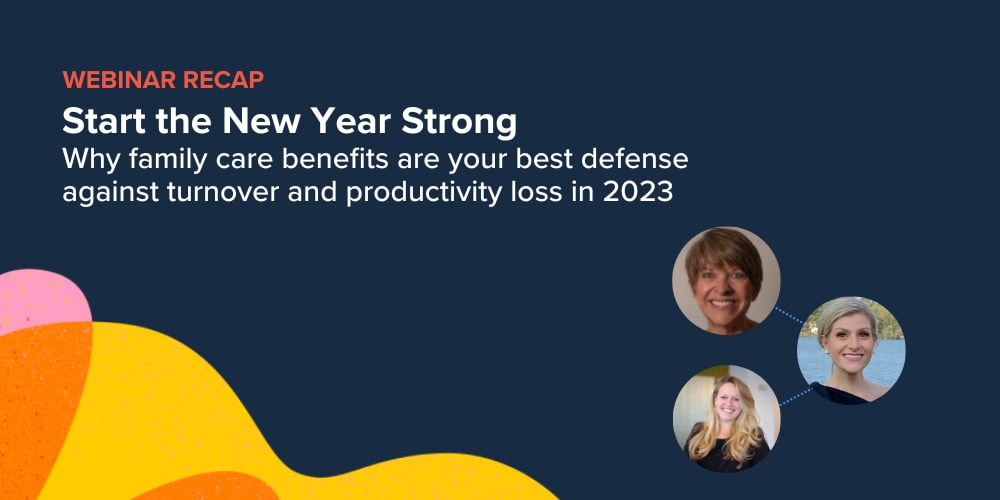The North American HR Executive Summit (NAHRES) brings the most innovative minds in HR leadership together to share new learnings with peers, and learn about the latest in HR technology and benefit advances. This year’s agenda focused on corporate culture, employee experience, performance management, and recruitment and retention strategies.
Our team attended sessions, networked with leaders and advocated for working caregivers everywhere over the three day event. Here are three key takeaways from NAHRES ‘22 to incorporate into your year-end strategy.
The workforce as we know it is hybrid.
We all agree. Work-life looks a lot different than it did pre-pandemic. The events of the last few years catalyzed a moment of reflection for employees and employers alike – creating a space for a reimagination of the workplace.
Care.com partnered with Mother Honestly recently to produce The Modern Workplace Report, research designed to uncover the flexibility and sustainability of the remote work revolution.
According to our findings, 76% of caregivers say remote work improves their overall quality of life, and 77% of their managers agree. Data to support the positive outcomes of hybrid and remote work is being found across a majority of industries. An increase in employee retention, overall well being and increased productivity is no longer anecdotal evidence.
Dell Technologies’ Chief Human Resources Officer, Jennifer Saavedra, led a session at the event outlining the work her team has done over the last few years to debunk common myths held about hybrid work.
Myth #1 – New Hires won’t feel included if they are remote
In reality, their data shows that team members hired since the start of the pandemic feel just as included as those hired before 2020, have strong relationships with their teammates, and are at no greater risk of leaving the company than anyone else. Dell’s tenure population attrition is below the current tech market’s.
Myth #2 – Individuals working onsite have an advantage for career advancement over those working remote
They have found no meaningful differences in promotion rates, employee performance, employee engagement or rewards. Employees have also noted they have little concern about potential differences in advancement.
Myth #3 – Hybrid work puts the company’s culture at risk
94% of Dell team members say the company’s behaviors are consistent with their published culture code. Even those hired post-pandemic.
Even with a wide array of data available across different industries, some organizations are still struggling with the idea of a permanently remote or hybrid workforce. As an HR leader it is important that you continue to bring the voice of your team members to leadership.
Approach these conversations with an understanding of leadership’s perspective, while presenting the facts. What is going to drive business impact? What will improve your retention and talent attraction efforts?
Remember, your best strategy is looking ahead, not trying to find your way back to the past.
Mental health is driving our youth where they want to work.
Headlines today feature our newest generation in the workforce, Gen Z. They value mental health support from their employers more than any other generation before them. Collectively they are more socially conscious, more in tune with their personal well being, and the fact is, Generation Z is slated to make up 27% of the workforce by 2025. Recognizing this, top companies are finding ways to prioritize employee’s total wellness.
Supporting your teammates’ total wellness means supporting them physically, financially, and emotionally. Organizations are finding caregiving support for working caregivers is one of the most impactful ways to boost emotional wellness.
A majority of today’s workforce is currently dealing with a caregiving responsibility on top of the daily expectations from their job. This could mean taking care of a child, an elderly adult, or even a pet. Providing family care support outside of your typical employee assistance program (EAP) has been proven to not only reduce stress among caregivers, but also increase retention rates.
70% of employees in our Care for Business customer survey stated they are more likely to stay at their current company because they have access to family care benefits. This can include membership to our Care platform, where families can find background-checked permanent care solutions, and Backup Care when regular plans fall through.
Companies that want to remain competitive must start supporting the most marginalized people in their organization.
Diversity, equity, inclusion, and belonging has been top of mind for a majority of HR executives over the past several years. A company’s DE&I efforts are no longer just a simple checklist to say you’ve done it, but instead a strategy to create an inclusive, equitable, and sustainable culture weaved throughout all facets of the business.
One way to ensure your company is boosting its diversity efforts is by offering a work/life benefit program to employees, according to a report published by Harvard Business Review this year. They explored data from more than 800 companies over the span of the last 30 years. Companies that offer work/life benefits have higher productivity, less turnover, employees with better physical and mental health, and a higher percentage of women and people of color in management positions.
To support the unique needs of each individual employee, organizations can provide access to services like Care Specialists. These are expertly trained and highly qualified specialists that include master’s level social workers to help employees navigate different obstacles in their daily lives. These experts provide prescriptive solutions for life events, like a child going off to college, natural disasters, estate planning, career development, special needs care, and so much more.

